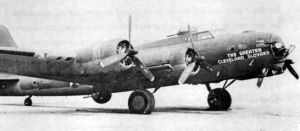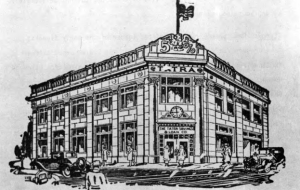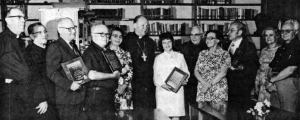Part IV: The Slovak Community of Cleveland
Slovak Community Leaders
As we have seen, at first it was seldom financially possible for the Slovak to send his children beyond grammar school, but, with the acquisition of homes and improved living conditions, the number of children in high school increased rapidly. Eleanor Ledbetter noted that in 1918 there were only four professional men of Slovak descent: two physicians and two lawyers. But, by the 1940’s the picture changed, because by then many more Slovaks had left the factories to go into business for themselves and were entering into the professional fields as well.
The following is a list from a wide spectrum of Cleveland Slovaks who, in some way have distinguished themselves and have contributed to their heritage and community. However, as all lists, this is an imperfect one and we will be guilty of omission, but not deliberately. We beg your indulgence.
Clergy
Rev. Stephen Furdek, gifted leader of the early Slovaks; Rev. Gregory Vaniscak, O.S.B., founder of the Slovak Benedictines in Cleveland; Msgr. Francis Dubosh, P.A., guiding spirit for Lakewood’s Roman Catholics; Abbot Stanislaus Gmuca, O.S.B., first Slovak Benedictine Abbot; Msgr. William Novicky, Ph.D., Superintendent of Schools for the Diocese of Cleveland for many years; Rev. Matthew Benko; Rev. John Humensky, STD., Ph.D.; Abbot Theodore Kojis, O.S.B.; and Abbot Jerome Koval, O.S.B.
Industrialists
V. Sarmir, W. Lorence, P. Janko, M. Olle, Bobinchuk and Sons.


Fraternal Organizations
John Sabol, Mrs. Sue Matuschak, Mrs. Anna Sotak, Martin Slimak, Joseph Dubnicka, Mrs. Louise Yash, Mrs. Tillie Bacik, John Pankuch, Sr., and John Kimpan.
Politicians
John Smolka, the first Slovak to be elected to the state legislature in Columbus; Judge George Tenesy, the first Slovak judge in Cleveland; Attorney Stephen A. Zona, member of the state legislature for about 20 years, Mayor of Parma for three terms and finally Judge of the Parma Municipal court; Mary Sotak, City Council-woman for many terms; Richard Harmody, Councilman; Victor Labutta, Councilman for the City of Parma; Steve Suhajcik, Councilman and later Commissioner for two decades in the City’s Utilities Department; Andrew C. Putka, attorney, member of the state legislature, superintendent of the state’s Savings and Loan Department, City Treasurer, and Director of Cleveland Hopkins Airport; John Petruska, Mayor of Parma; and George Matowitz (Matovich), Chief of Police in Cleveland for a quarter of a century.
Bankers
Joseph Sotak, Jr., President of the State Savings and Loan with headquarters in South Euclid, Ohio; and George E. Fedor, President of Home, Federal Savings and Loan with headquarters in Lakewood.
Radio Broadcasters
John Mazur and Kolman Lajcak began Slovak radio broadcasting in the early 1930’s. It continued with Joseph Pales of the Slovak Radio Club, John J. Biro of the Cleveland Slovak Radio Club, Michael Beno, Alex Mikula, and J.J. Koscak. For years George E. Fedor was co-announcer with John Biro. (The stations now broadcasting Slovak programs through the week and on Sundays are WXEN-FM, WZAK-FM and WERE-AM.)
Poets
Rev. Mikuláš Šprinc and Dr. Karol Strmeň.
Historian-Educator
Dr. Francis Hrušovský; Father Andrew Pier, O.S.B.
Authority on Slovak Archaeology
Dr. Joseph G. Cincik.
Architects
John Lipaj and John Pastirik, Jr.
Musicians
Sammy Kaye, a member of a well-known Slovak family in Lakewood is the most prominent of Slovak musicians from this area. George Szell, the famed conductor of the Cleveland Orchestra, acknowledged that his mother was a Slovak. Two Slovaks, Francisci and Orsagh were well-known as composers of classical music at the beginning of the century. Many may still remember the popular orchestras of Sedlak, Pales, Goldun and Beno as well as bandleaders John Rozboril of St. Ladislas and Ray Zamiska, who directed the Catholic War Veterans’ Band at St. Benedict. Today John Pastirik and Joe Kopcho have come to the forefront with their music. Foremost in church music were men like George Lukac, Sr. and Joseph Duris of St. Benedict and Matt Lucas, the choir director of St. John’s Cathedral for more than 33 years.
Sportsmen
In the 1920’s and early 1930’s Johnny Risko, a heavyweight contender was a prominent figure. Ollie Downs (Kaplafka) and Andrew G. Putka were well-known as boxing commissioners.
Travel Agents
Atlas Travel, John Olds; Adventure International Travel, Andrew Hudak, Jr. who is also honorary president of the Northern District of the Slovak League of America after serving many years as president; Groger Travel; and Lihani-Nemecek Travel Bureau.
There are many Slovaks in the various professions such as law, education, and medicine as well as in business enterprises such as taverns, general stores, funeral homes, and so on. Cleveland Slovaks have also contributed substantially to the ranks of the priesthood and to religious life in general as there are several hundred nuns of Slovak ancestry in the various religious orders, as well as more than a hundred priests and religious brothers in the diocese.
Cleveland has played an important part in the lives of the Slovaks, and, they in turn have made many contributions to her. In singling out the most important contribution made by the Slovak people, we would concur with the feelings of Father Andrew Pier in his historical review of Cleveland, where he acknowledges the importance of building a faith community, both physically and spiritually:
“One should be mindful in evaluating the assets of various ethnic peoples in America that not the least of their lasting contributions was their constant building of religious institutions, namely, churches, schools, convents, etc. These projects were certainly welcome to the building trades and added greatly to American progress and prosperity. This was true in the city of Cleveland and throughout the country as well. There also is no way of assessing the spiritual benefits derived by millions of our fellow citizens. Nevertheless, it does not take an expert to see the contrast between these religious-inspired communities and those that have no faith.”
Writing his historical review of the Slovak people in Cleveland on the occasion of our nation’s Bicentennial celebration, Father Pier concluded his article:
“Cleveland Slovaks are perhaps more aware of their many contributions than others . . . perhaps not. But in view of the above facts (his historical review), no one can deny the impact of the Slovak community on the city of their choice. Together with thirty or forty ethnic groups of their fellow citizens who cherish respective traditions of their forefathers from many lands, they can justly claim that each in their own way helped Cleveland ‘the best location in the nation’ or at least favorably comparable to any cosmopolitan community in the nation. This is no empty boast by any means in the light of our united share in the heritage of a great cosmopolitan metropolis on the shores of Lake Erie and in the very heart of our great country.”

Silver Jubilee of the Slovak Institute (Cleveland, Ohio)
June 22, 1977
From right to left: Fr. J . Humenský, STD; Fr. A: Pír OSB, Director of the Institute; J. Koščák; Fr. M. Šprinc; Mrs. Olga Strmeň; Abbot Jerome Koval, OSB; Mrs. Adele Hrušovská; Abbot Theodore Kogiš, OSB; Mrs. Maria Mihalovičová; Dr. K. Strmeň; Mrs. J. Koscak; V. Mihalovič.
Source: KALENDÁR JEDNOTA 1978
